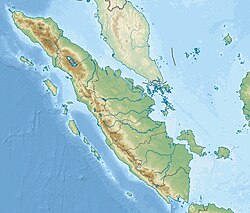The 1943 Alahan Panjang earthquakes occurred on June 8 and June 9 UTC (June 9, 1943, local time) in Sumatra, then under Japanese occupation. This was an earthquake doublet (the shocks occurred at the same location on consecutive days).[5]
| UTC time | Doublet earthquake: |
|---|---|
| 1943-06-08 20:42:46 | |
| 1943-06-09 03:06:20 | |
| ISC event | |
| 899871 | |
| 899872 | |
| USGS-ANSS | |
| ComCat | |
| ComCat | |
| Local date | June 9, 1943[1] |
| Local time | |
| 03:42:46 | |
| 10:06:20 | |
| Magnitude | |
| Ms 7.5[2] | |
| Ms 7.8[3] | |
| Depth | 15 km (9.3 mi)[2] 10 km (6.2 mi)[3] |
| Epicenter | 1°00′S 101°00′E / 1.0°S 101.0°E[1] |
| Areas affected | Indonesia |
| Max. intensity | IX (Destructive) (both events)[4] |

The first mainshock occurred on June 8 at 20:42 UTC. It ruptured the Suliti segment of the Sumatran Fault Zone. The magnitude was given as Mw 7.2,[1] or Ms 7.1.[6]
The second mainshock occurred on June 9 at 03:06 UTC. It ruptured the Sumani segment of the Sumatran Fault Zone and perhaps the northwestern part of the Suliti segment. The magnitude was given as Mw 7.5,[1] or Ms 7.4.[6]
Alahan Panjang was damaged in the earthquakes.[5] Right lateral offsets were reported near the town of Solok.[6]
Near the Sumani segment, earthquake doublets occurred repeatedly.[7] Similar earthquake doublet nearby include the earthquakes in 1926 and 2007.[8]
See also
editReferences
edit- ^ a b c d Engdahl, E. R.; Vallaseñor, A. (2002). "Global seismicity: 1900–1999" (PDF). International Handbook of Earthquake & Engineering Seismology. Part A, Volume 81A (First ed.). Academic Press. p. 678. ISBN 978-0124406520.
- ^ a b ISC-OB Event 899871 [IRIS].
- ^ a b ISC-OB Event 899872 [IRIS].
- ^ Martin, S. S.; Cummins, P. R.; Meltzner, A. J. (2022), "Gempa Nusantara: A Database of 7380 Macroseismic Observations for 1200 Historical Earthquakes in Indonesia from 1546 to 1950", Bulletin of the Seismological Society of America, 112 (6): 2958–2980, Bibcode:2022BuSSA.112.2958M, doi:10.1785/0120220047, hdl:10356/166257, ISSN 0037-1106, S2CID 253365854
- ^ a b Natawidjaja, D. H.; Triyoso, W. (2007), "The Sumatran Fault Zone – from Source to Hazard", Journal of Earthquake and Tsunami, 01: 21, doi:10.1142/S1793431107000031
- ^ a b c Natawidjaja, D. H. (2003), Neotectonics of the Sumatran fault and paleogeodesy of the Sumatran subduction zone (phd), Dissertation (Ph.D.), California Institute of Technology, Bibcode:2003PhDT.........7N, doi:10.7907/KBXR-5B89
- ^ Nakano, M.; Kumagai, H.; Toda, S.; Ando, R.; Yamashina, T.; Inoue, H.; Sunarjo (2010), "Source model of an earthquake doublet that occurred in a pull-apart basin along the Sumatran fault, Indonesia", Geophysical Journal International, 181 (1): 141–153, Bibcode:2010GeoJI.181..141N, doi:10.1111/j.1365-246X.2010.04511.x
- ^ Aydan, Ö. (2007), A reconnaissance report on the 2007 Singkarak Lake (Solok) earthquake with and emphasis on the seismic activity of Sumatra Fault following the 2004 and 2005 great off-Sumatra earthquakes (PDF), Japan Society of Civil Engineers
External links
edit- The International Seismological Centre has a bibliography and/or authoritative data for this event.
